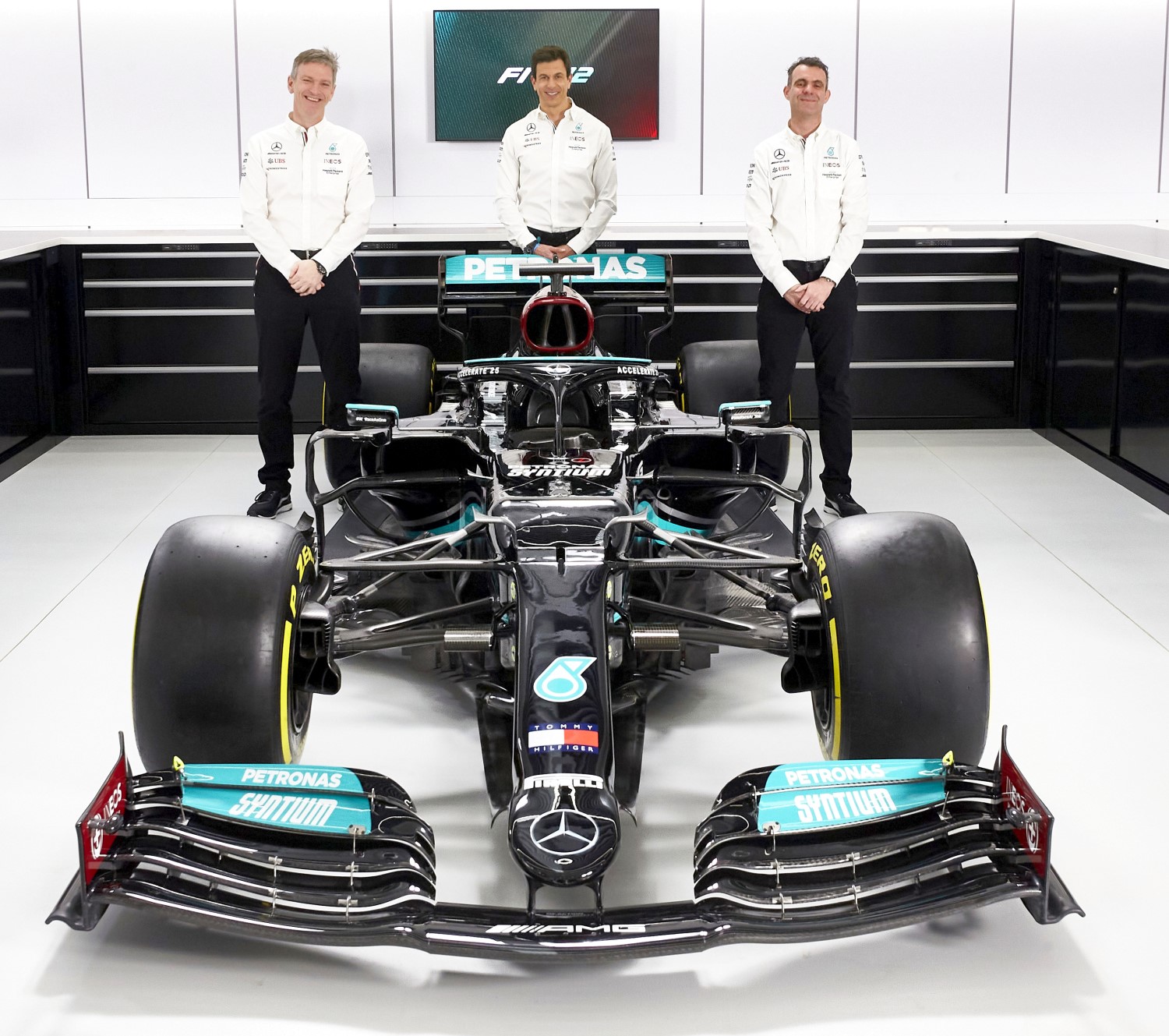Mercedes unveils their 2021 W12 F1 car
- The Mercedes-AMG F1 W12 E Performance builds on the solid base of its predecessor but includes considerable aerodynamic changes alongside improvements to areas as such as the suspension, cooling system and Power Unit.
- The black base livery remains for a second season, to underline the team’s commitment to improving diversity and inclusion within the team and our sport, with elements of the traditional racing silver incorporated alongside increased visibility for Mercedes-AMG.
- Toto Wolff: “Our skepticism and hunger drive us and get us fired up for every new season – because the scoreboard goes to zero and there’s always more performance to be found. And that’s exciting.”
- The W12 will complete its first laps on the opening day of pre-season testing in Bahrain, on Friday 12 March.
Just 12 weeks after the checkered flag fell on the 2020 Formula One season, the Mercedes-AMG Petronas Formula One Team has officially revealed its challenger for the 2021 season. The Mercedes-AMG F1 W12 E Performance is presented today in the brand-new Race Bays at our Brackley technical center, officially opening a cutting-edge facility that has been created over the past 18 months.
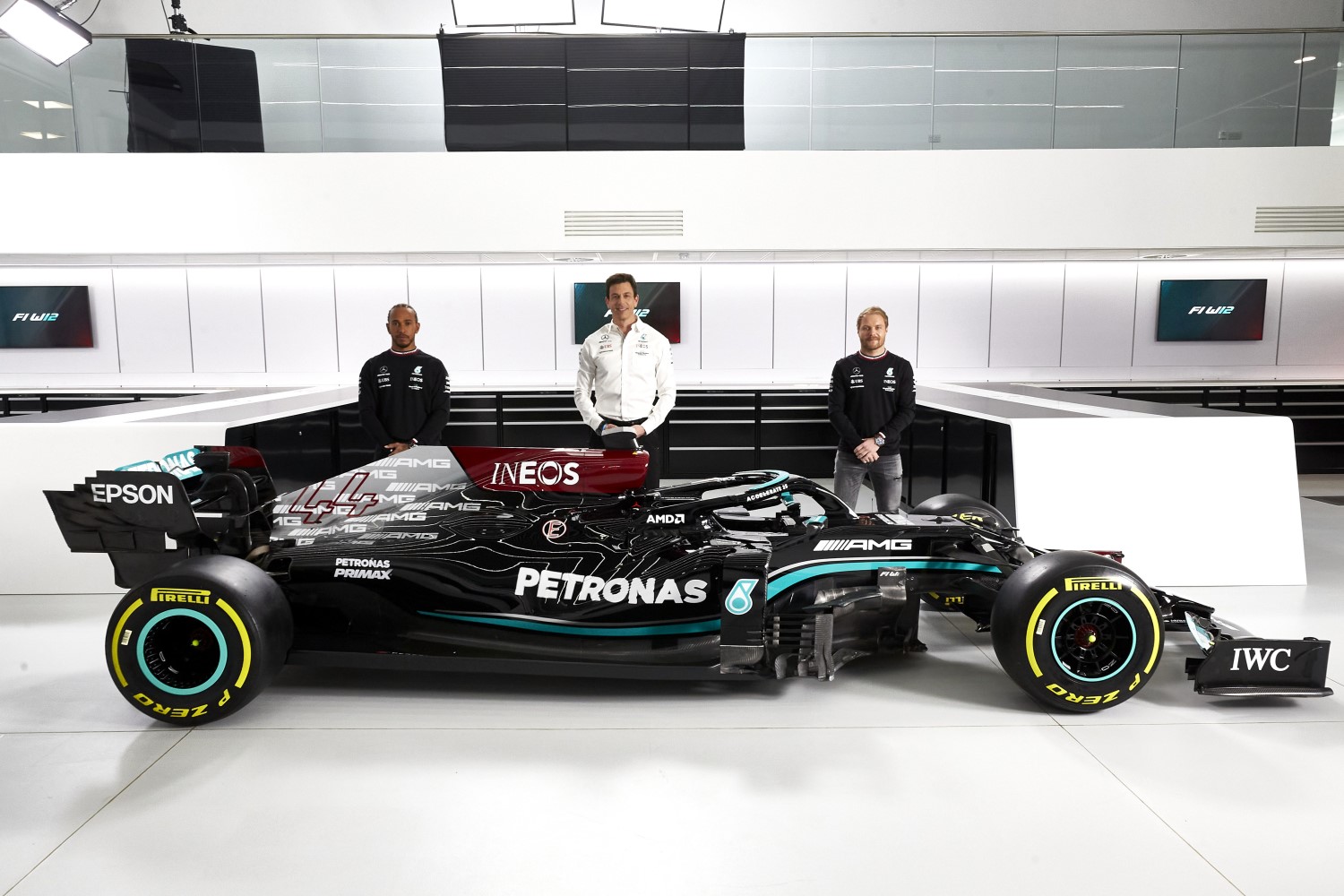
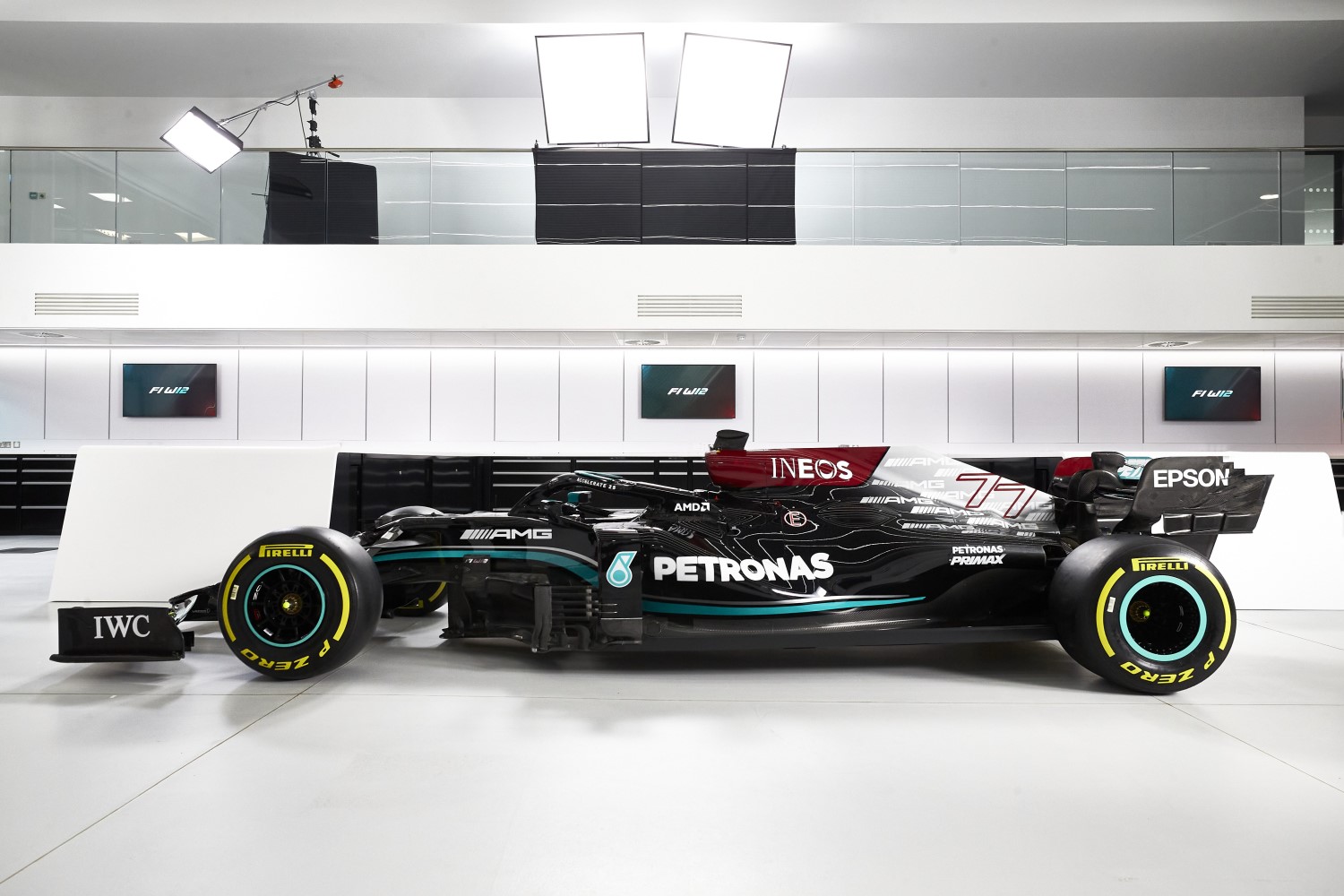
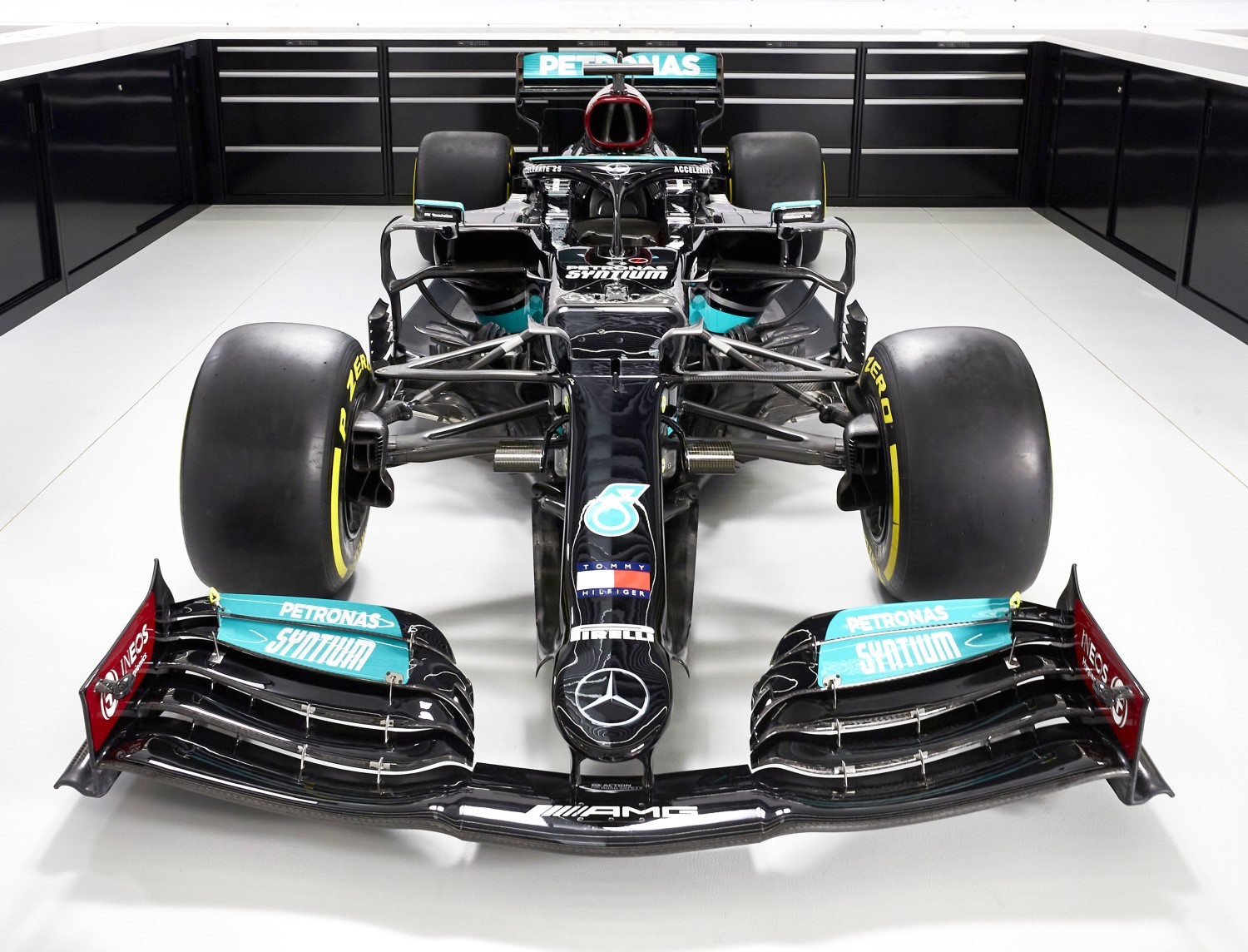
The factories have been a hive of activity over the winter, as team members searched for new solutions, opportunities and improvements in their hunt for performance. Long days, late nights, tough decisions and intense deadlines – the combined and collective effort of every member of the team, coming together to ensure W12 is ready to hit the track on schedule.
“Every year we reset our focus and define the right objectives,” said Toto Wolff. “That may sound simple but it’s damn hard and is probably why there are no sports teams out there with seven consecutive titles. So many things can happen and it’s very natural to get used to success, and therefore not fight as hard for it.
“But this team has not shown any of that. I see the same fire, hunger and passion now as I did the first time I walked through the doors in 2013. Every season presents a new challenge and therefore, a new goal for us to achieve. 2021 brings changes to the regulations, which could impact our competitiveness, plus the cost cap and working on the major rule changes of 2022. These challenges excite us.”
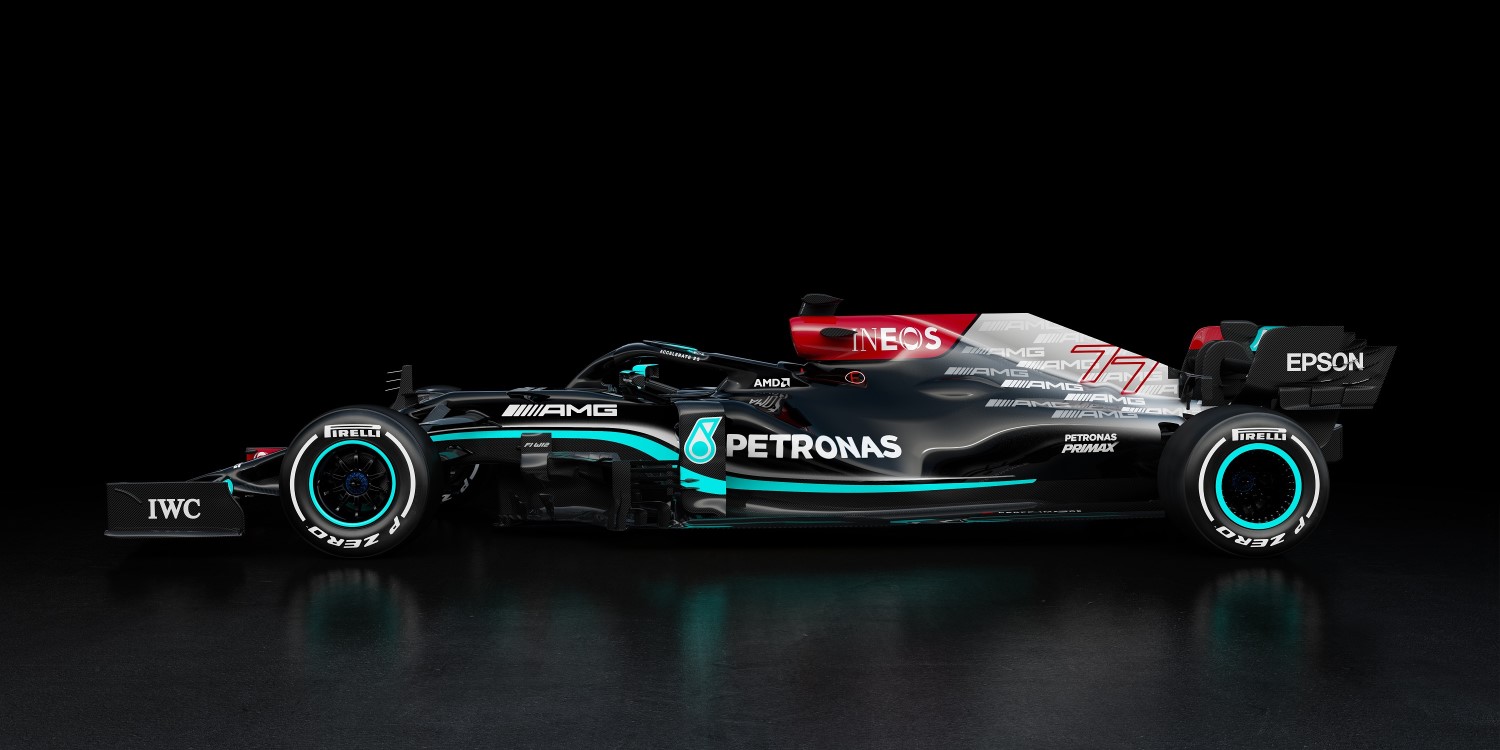
The team’s 2021 challenger is named Mercedes-AMG F1 W12 E Performance and is our first car to use the ‘E PERFORMANCE’ designation, signifying our closer alignment to the Mercedes-AMG performance division in the future. ‘E PERFORMANCE’ is the new technology label that will be used in product names and badges on all forthcoming Mercedes-AMG performance hybrid cars – which feature direct cascade technology from F1 and, in particular, the work of Mercedes AMG High Performance Powertrains in Brixworth.
The team’s closer cooperation with AMG is also reflected in the new 2021 livery, with AMG branding replacing the star pattern on the engine cover which now fades to Mercedes’ traditional racing silver from the black base livery introduced in 2020. The most prominent color remains the iconic green of Title Partner PETRONAS on the front and rear wings, nose, mirrors and halo, with the parallel green and silver stripes on the flanks of the car symbolizing more than a decade of partnership between Mercedes and PETRONAS. The visual identity is completed by the burgundy of team shareholder and Principal Partner INEOS, which features on the airbox and the inside of the front wing end plates. The result is a striking and distinctive look for the season ahead.
This season also marks the beginning of an exciting new chapter for the team following the announcement late last year that Toto, Daimler and INEOS will be one-third, equal shareholders.
“The fact that we were able to attract INEOS as an investor shows that we have a strong business case and that F1 continues to be a highly attractive platform for big brands and companies,” said Toto. “We’re also seeing a slight shift in the way that F1 teams operate as the cost cap and the new structure move us towards a business model that is more familiar in American sports franchises.
“At the same time, having three strong shareholders in the team gives us even more stability for the future. On a personal level, I’m very happy to commit to the team for the long term and increase my share slightly. I’ve always said that this team is like a family to me, and I’m incredibly proud of what we have achieved together.”
Significant aero changes for the 2021 season
The biggest technical challenge on the 2021 F1 cars has been adapting to the new aerodynamic regulations, with the introduction of several significant changes to key performance areas on the car.
“If you’re looking to slow a car down, which is effectively what the regulation changes were intended to do, modifying the floor is by far the easiest and cheapest way of achieving your objective,” said James Allison. “The floor is such an important aerodynamic component that small geometrical changes bring large reductions in performance. Once the rules had been established, our task was to figure out how to recover the losses brought by the changes.”
That has been a significant challenge for our designers, trying to claw back performance from these regulation changes. The four key modifications to the floor are:
- A triangular cut-out on the edge of the floor, in front of the rear wheels.
- Reducing the span of the rear brake duct winglets, by a few centimeters.
- Reducing the height of the two inboard strakes nearest the car centerline in the diffuser.
- Sealing up the slots in the floor around the bargeboards.
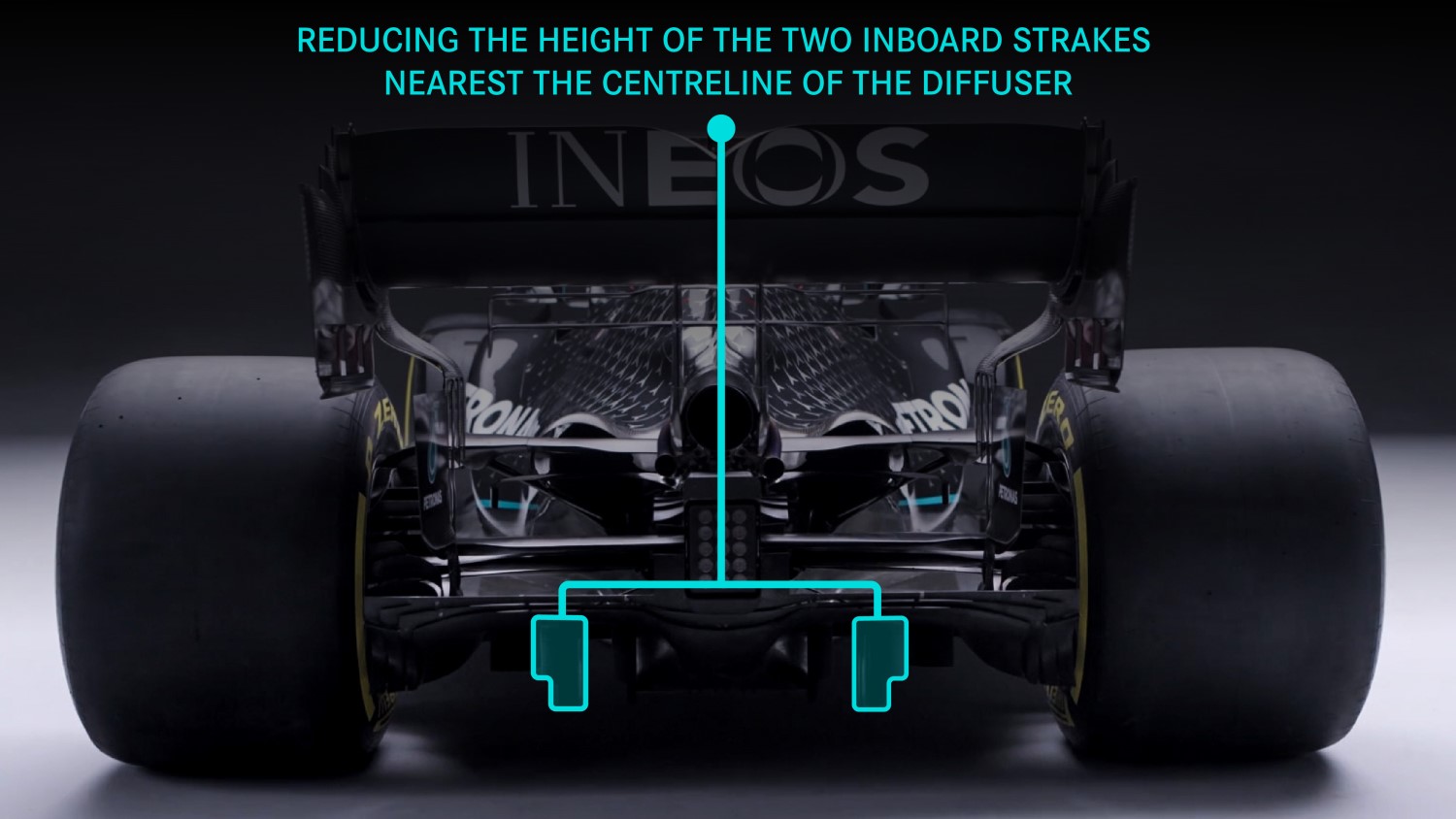
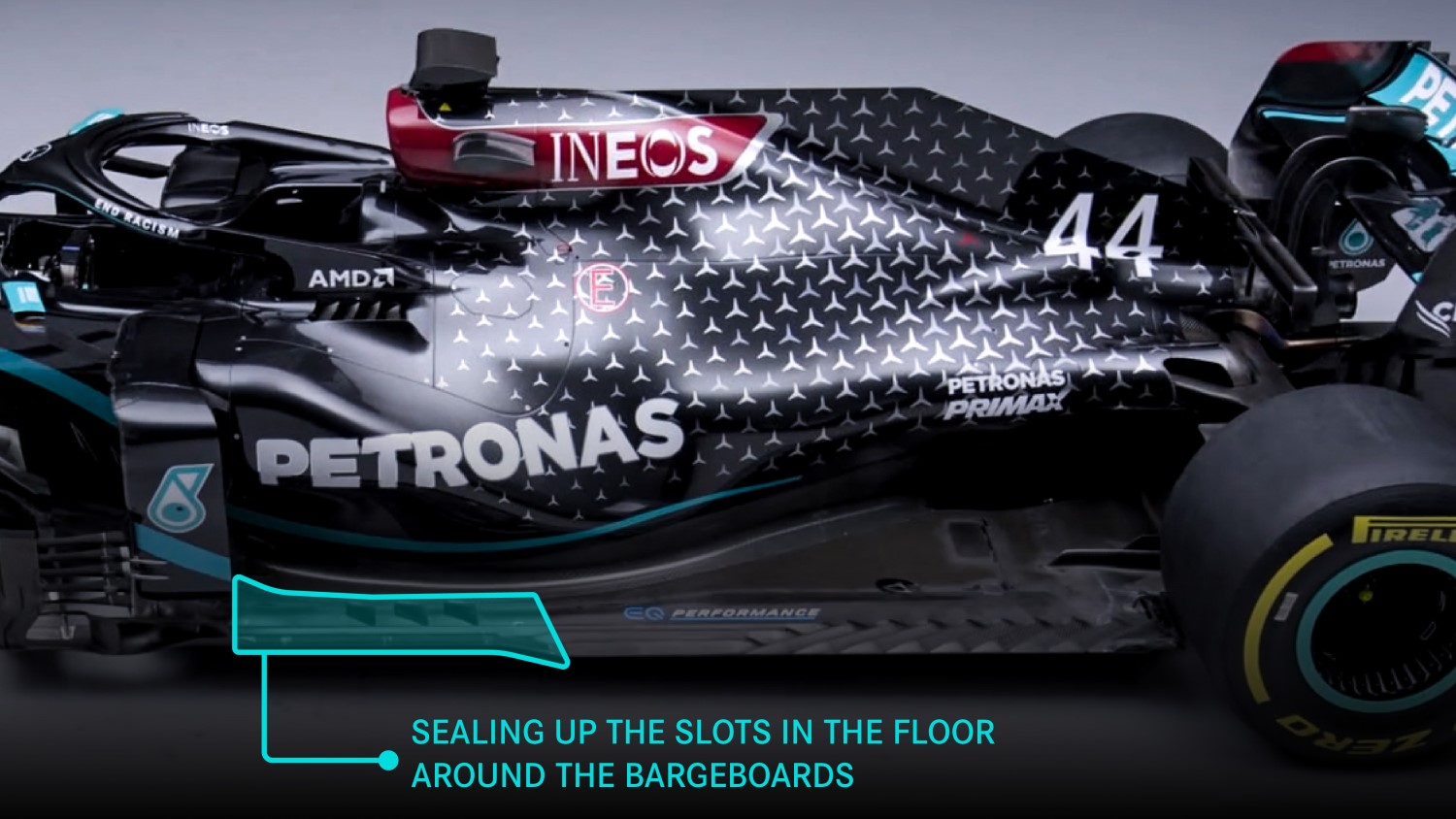
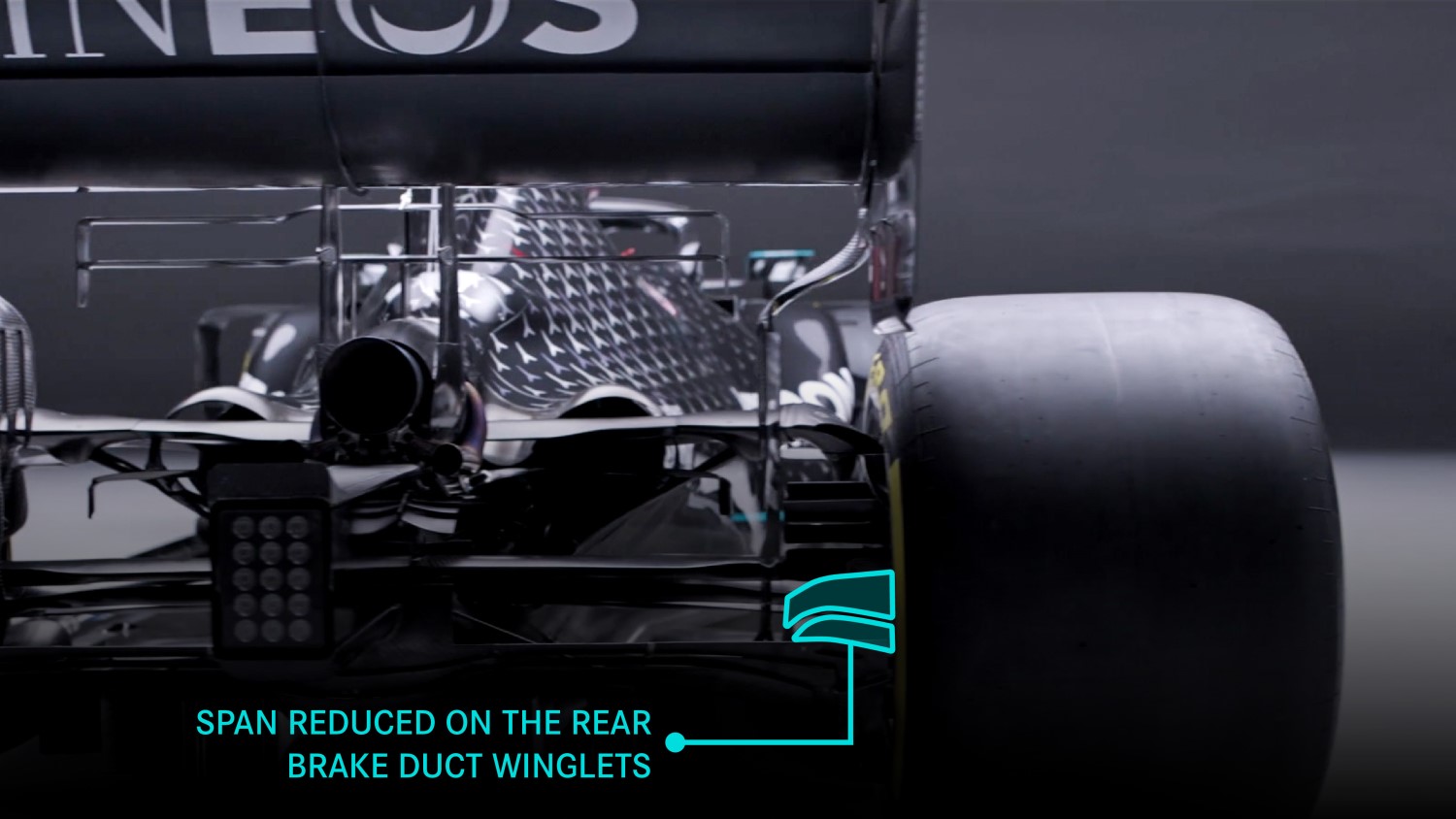
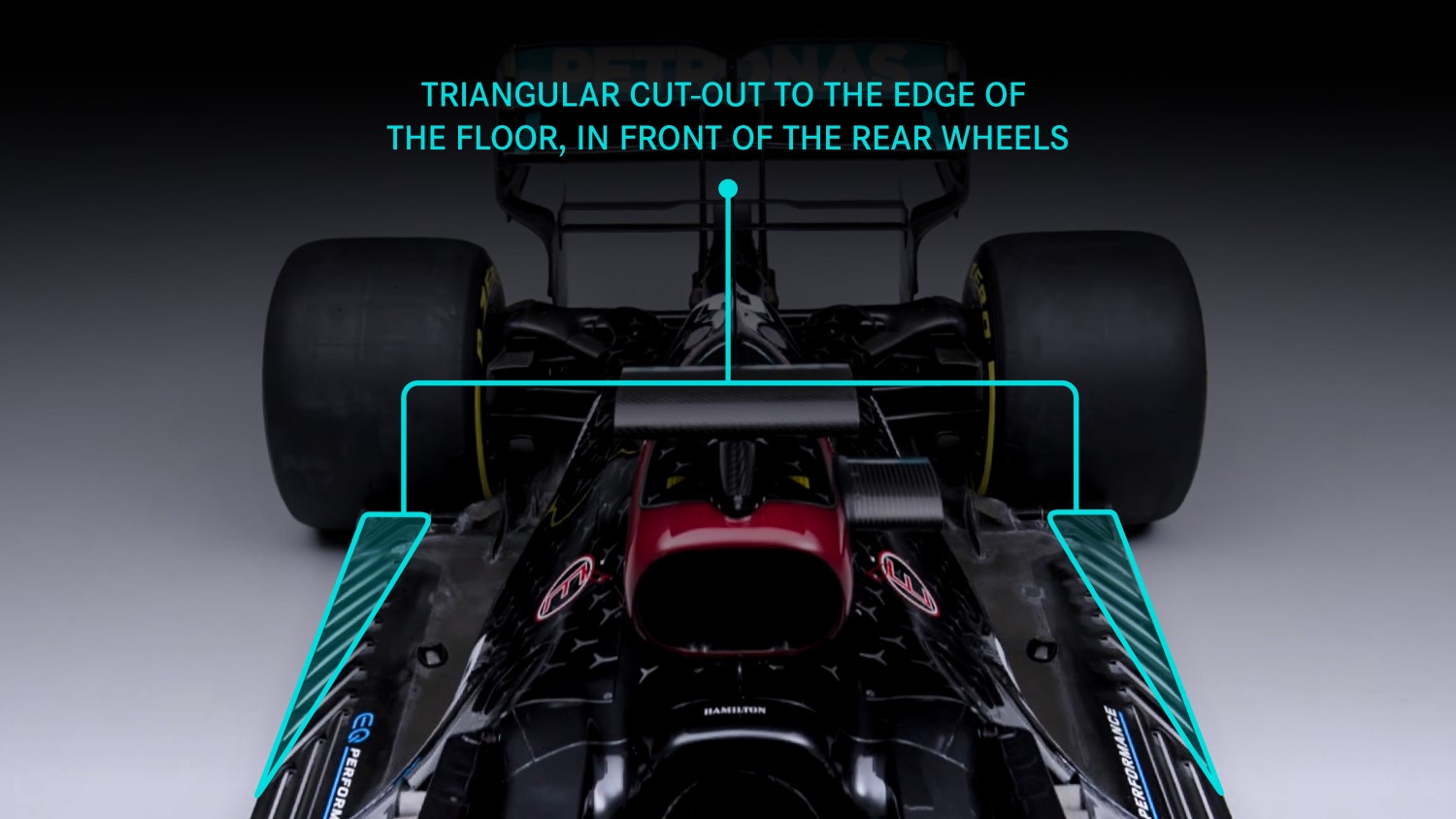
The aerodynamic changes have been a key focus in the development of the W12, but some of the parts on our new car are identical to the W11 owing to the new carryover rules. In some ways, this has lessened the peak of work required for the new car, but it’s also produced its own new challenges and difficulties.
“What’s carried over will look different from team to team, because the rules didn’t require you to carry over the same things,” explained James Allison. “The rules freeze a large chunk of the car, but then give each team two tokens to spend on changing their car. Along with the tokens comes a shopping list showing how many tokens are required for each change. How teams decided what to use their tokens on was entirely up to them.
“In addition, there are some parts of the car that you can change token-free, for example the Power Unit, the cooling systems, the suspension and of course all of the aerodynamic surfaces. We have spent our tokens, but we won’t reveal how we used them just yet. That’ll become clear in good time. Once the racing gets underway, pretty much everything under the skin of the car must then be frozen for the entire year. With the specific permission of the FIA, you can make changes for reliability or cost saving, but if part of your car isn’t performing well, then you are stuck with it for the whole season.”
The significant aerodynamic changes to the floor and adapting to the carryover rules have kept the team busy, but there are opportunities for improvement in many areas of the car, and our engineers have been working tirelessly to find an edge.
“Our other aerodynamic work has been the normal fare of seeking out aerodynamic opportunity across every square centimeter of the car with particular attention to finding places where we can invest extra weight into fancier aerodynamic geometry,” James added.
“2021 permits the cars to be 6kg heavier, and we have an additional few kilos to spend as a result of DAS being banned. Beyond this, the carryover rules have confined us to figuring out how we can make some parts live longer, so we don’t have to replace or buy them so often.”
There are new Aerodynamic Testing Restrictions (ATR) coming into force this year, with the general amount of time allocated for wind tunnel testing and CFD testing being reduced. On top of that is a form of handicapping, granting teams less or more access to these aerodynamic tools depending on their championship position. Therefore, because of our Championship victory in 2020, we will have 22% less access in 2021 compared to the last-placed team.
“We have always tried to get the most out of every wind tunnel and CFD session, but there’s nothing like having a new constraint imposed to renew the spur to become more productive and efficient,” James said. “We are determined to find better ways of working so that we can mitigate the effect of this handicapping.”
Pirelli is introducing a new, more durable tire this season, which teams trialled last year in Portimão, Bahrain and Abu Dhabi. None of the teams have had a lot of experience with it and with only three days of pre-season testing this year, every lap on track will count to get up to speed with these new tires.
“The tire is a little slower, owing to the trade-off for more durability, but it is consistent and should give us trouble-free racing,” James said. “However, it will be an interesting competitiveness factor during 2021. Any time a tire changes, it is always a learning race between the teams to find its sweet spot – where the new rubber gives its best performance.”
These different elements stack up to present a significant challenge for 2021 and make it far from a simple ‘carryover’ year. But while the 2021 season may be staring us in the face, we also have a team of people working on the extensive regulation changes for 2022.
“The ideal situation would be to have a car that is so brilliantly fast, you can almost turn your back on it immediately and focus on the next one,” said James. “But Formula One is never that simple. The siren call of the 2021 racing campaign will inevitably draw our attention from the seismic changes of the 2022 regulations.
“We will walk a tightrope all year between doing enough to be competitive in 2021 and putting as much as we dare into 2022. Managing the bird in the hand and the one in the bush is the eternal challenge of F1 and doing so in the face of both the cost cap and the completely new 2022 technical regulations will be a challenge like no other.”
Finding the edge with the Power Unit
Developing the new M12 Power Unit, Mercedes AMG High Performance Powertrains have been chasing every possible improvement to deliver a step forward when it hits the track in all eight of the cars it will power this season.
“We are going into the eighth season of pretty stable regulations, so we have a good understanding of the current hybrid engines,” said Hywel Thomas. “Our new product is a characteristic Mercedes-AMG Power Unit, but we’ve worked hard to take the next development step. Stable regulations mean that it’s getting increasingly challenging to unlock additional performance, so you need a focused approach.
“We identified three main areas to work on: first, we’ve continued the development of the technology in the Power Unit. That’s a continuous process, and we feel like we’ve been able to take a step forward on that front again this year. The second area is reliability. We discovered some design issues last year, so we’ve been looking at those and introduced some changes to address them. And we’ve also got some completely new innovations that will be in the racing PU for the first time. That was particularly challenging because last season finished late, so the winter period has been shorter than normal and has given us less time to prepare, which put extra strain on the business.”
The hunt for every ounce of performance possible in the Power Unit has been emphasized even further by the regulation changes for 2021, which allow only a single performance specification of hardware rather than introducing upgrades at different points throughout the season.
There’s also been an increased production workload with McLaren joining the stable of customer teams, which has presented an exciting challenge over at Brixworth over the past few months. It’s the first time a McLaren has been powered by Mercedes since the conclusion of the 2014 season.
“A third customer team does put more pressure on the organization,” Hywel said. “We need to take more engines to winter testing, we need to take more engines to the first race, but we don’t want to freeze our designs any earlier because of that. So that puts some additional strain on the internal and external supply chains and the build and test team, to be able to develop the design for as long as possible. What we gain is another group of chassis designers looking at the PU, looking at how it works, how it’s integrated into the car, how it’s working with the rest of the package. We can add all those comments and ideas into the melting pot of this season and all the subsequent seasons.”
A number of restrictions to Power Unit development were introduced last year, in response to the COVID-19 pandemic, so this has been the first winter period for HPP working with the reduction in dyno hours alongside the singular performance specification for the hardware.
“It’s similar to how wind tunnel usage has seen restrictions for a number of years, but we had to implement the restrictions with immediate effect for the dyno,” Hywel said. “Now, we need to decide earlier what projects to focus on, because we can’t afford to use precious dyno hours on ideas that end up not making it to the car.”
Meanwhile HPP is also working on the significant modifications to the regulations for 2022. While the changes on the Power Unit are not quite as revolutionary as on the chassis side, there’s still a lot of work to do and balancing the requirements of 2021 alongside the preparations for 2022 will be a big challenge over in Brixworth.
“Starting in 2022, F1 engines will be powered using E10 fuels – so fuels that contain 10 percent ethanol,” said Hywel. “This might not sound like a radical change, but it changes the combustion process significantly, so there’s a lot of development work to be done. There are also some changes around the ERS components.
“Obviously, the biggest changes in 2022 are on the chassis side, which are enormous. That also impacts all of us in Brixworth because putting the PU into a completely new chassis means there will be some changes where the PU is mounted. As the chassis engineers become more knowledgeable on what they need for the car to go quickly, and how they need to position all the systems within the chassis, the impact on the PU will become clearer as well.
“We had already started work on that, as the regulations were originally going to be implemented this year, but now the real challenges begin. We are full steam ahead to optimize the PU for those significant new regulations. So, our ability to find ‘the winners’, the ideas that have the potential to give us an advantage, and back them with the correct amount of resource to develop and deploy them, is going to be key this year.”
Working under the cost cap
Perhaps the biggest challenge for the team this season will be working under the new cost cap regulations. The budgets of all F1 teams are capped at $145m for the 2021 season and this has required significant work behind the scenes to adapt to this new constraint. It’s also prompted the team to adapt its organization, including the creation of Applied Science – the high-technology engineering arm of the business.
“We had to change the structure of our team, the way we work with each other, streamline our processes and become more efficient,” said Toto. “And we fundamentally believe that the more efficient we are, the more performance gain that will translate to out on the circuit. So, it’s had a huge impact, but it has also provided us with the opportunity to re-evaluate our organization. That’s why we set up Applied Science, bringing F1 know-how to many different customers, and it’s going to really play a big part in our evolving business.”
From a technical perspective, the cost cap regulations require us to manage resources more judiciously through the year and make sure we spend every single dollar of cost cap money as effectively as possible. The carryover rules for 2021 have somewhat cushioned the impact on this year’s car, but as the year progresses and attentions turn to 2022, the cost cap constraints will be felt more keenly.
“We will try to ensure that we protect the rate at which we learn how to make the car go faster, but the cost cap will inevitably change the intervals between updates,” James added. “We will have to wait longer, and combine the gains into bigger steps, before we spend the money to manufacture them, in order to ensure we don’t run out of development budget early in the season.”
Focus on diversity, inclusion and sustainability
Last season, we raced with a black base livery as a public pledge for greater diversity and inclusion within both the team and our sport. This was the start of a long journey and we’ve made some important initial steps in recent months, with much more still to come over the course of this season and beyond.
The black base livery remains for the 2021 season as a sign of the team’s continued commitment to becoming more diverse and inclusive as a company. Projects such as the partnership with the Mulberry Schools Trust, the development of the Accelerate 25 program for the team and a new foundation that we will jointly create with Lewis mark the very start of this journey.
“We have rolled out training for our recruiters to sensitize them on unconscious bias and all our managers have completed our inclusive excellence program,” added Toto. “At the same time, we’ve set ourselves the goal of at least 25 percent of all new starters coming from under-represented groups for the next five years. The latest step is a joint foundation that we will create together with Lewis to improve all aspects of diversity in motorsport.
“All of these measures are encouraging, but we know that real change takes time and we’re at the start of a very long journey. So, this topic will very much remain in our focus for years to come as we build on the foundations we’ve laid over the past few months.”
Working to make the team more sustainable is also an important focus, after achieving a net-zero carbon footprint at the factories in 2020 and becoming just the second F1 team to be awarded FIA Three-Star Environmental Accreditation late last year.
“We’re continuing to push forward with our sustainability projects in 2021, with the aim of cutting our CO2 footprint by 50 percent by 2022 compared to 2018,” Toto said. “A lot of work is also going into sustainable fuels for the future, particularly in Brixworth. Working alongside our title partner PETRONAS, the first step in the direction of sustainable fuel is the introduction of the E10 fuel for 2022, but all the Power Unit manufacturers and fuel manufacturers are also looking further down the line to a 100 percent sustainable fuel. It’s a really intriguing challenge that we’re facing.”
Driver line-up stability for a fifth consecutive season
While the world around us and the environment we are working in are constantly changing, we enjoy stability in the team’s driver line-up for the 2021 season with Lewis and Valtteri entering their fifth season as team-mates. Both are looking forward to getting back in the cockpit after the winter break, which included intense winter training programs.
“The launch day of a new car is always a really exciting one,” said Lewis. “It’s great to reveal to the world the result of everyone’s hard work at the factories and to see some of my team-mates in person, which has been so rare during the past year. I’ve been in touch with the engineers through the winter, keeping track of their preparations as I prepare myself for the season ahead. The excitement has been building and building, so now I just can’t wait to get out on track in the W12.”
“Obviously we haven’t been able to visit the factory much in the past year, so firstly, I’m really happy to be back here and to see the new car in person for the first time,” said Valtteri. “I’ve been getting regular updates on how things are progressing, so it’s nice to now be able to see the end result in the flesh and that just gets me more fired up for the new season. The cars are pretty similar to last year but there are some interesting aero changes that will have an impact on how the car handles and performs, so I’m looking forward to seeing how it feels on track in Bahrain.”
“I think the consistency we’ve had within this team over the years has been a real strength and advantage of ours,” said Toto, on the driver line-up for 2021. “As we’ve seen in past seasons, it’s a line-up that works well for us, with two incredibly strong drivers who also have a very professional working relationship together. Both are hungry and fired-up to get back racing again soon and we’re all looking forward to seeing them drive our new car in anger for the first time in a few weeks.”
We also have a strong Reserve Driver line-up for the 2021 season, with Stoffel Vandoorne continuing in the role alongside his Mercedes team-mate in Formula E, Nyck de Vries.
